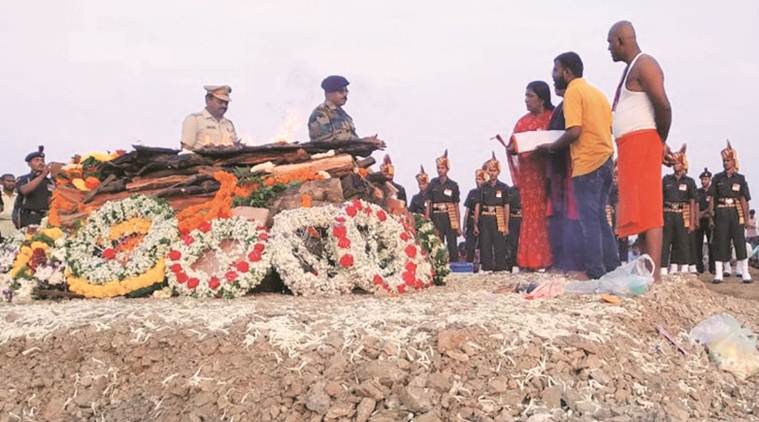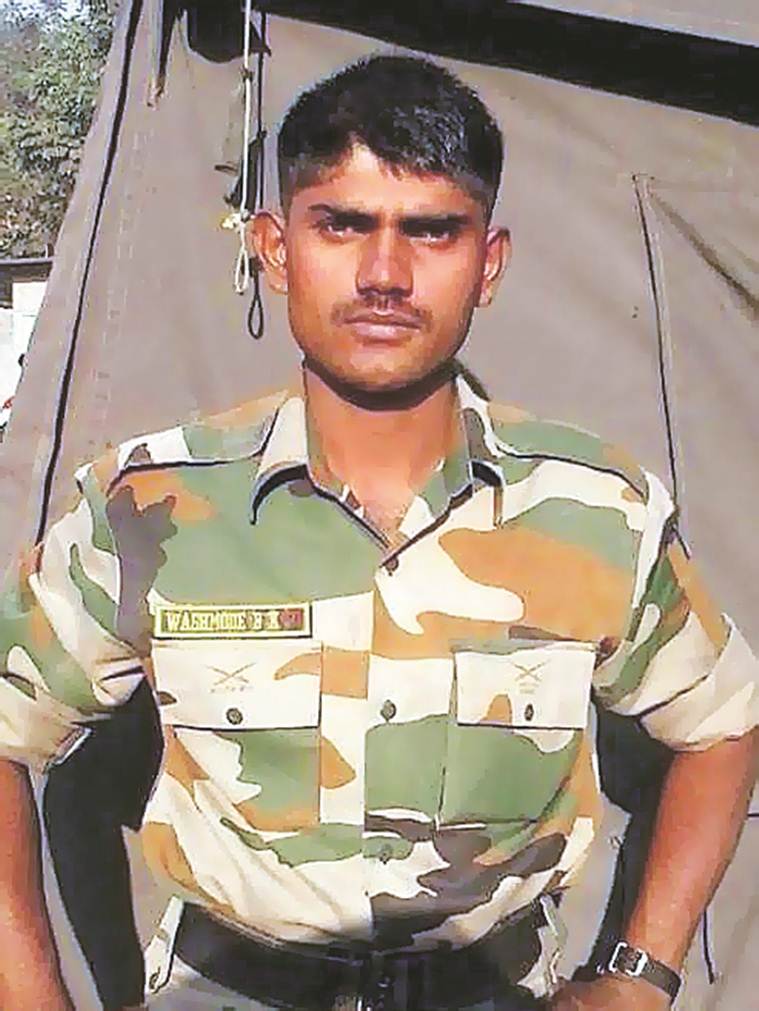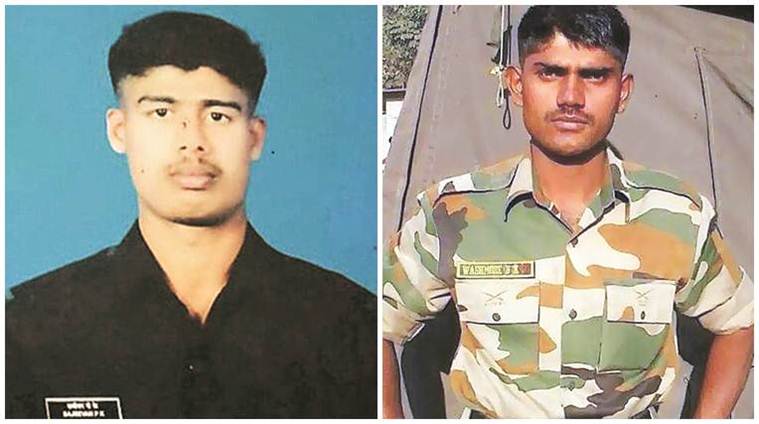
The last rites of Naik Bhiva Waghmode were conducted at his native village Bharatgaon in Daund on Friday. (Express)
A day after two Army soldiers were killed in an accident during a bridging exercise at the College of Military Engineering (CME) in Pune, the family members of one of them, Naik Bhiva Waghmode (29), demanded a thorough probe into the causes of the accident and necessary action based on it.Waghmode and Lance Havildar Sanjivan PK (28) were killed in an accident during a training session for the construction of a suspension bridge on CME premises on Thursday. Nine others, including an officer, had sustained injuries in the accident. All the injured are stable, defence officials said on Friday.
The Court of Inquiry (CoI), which was ordered to probe the incident, commenced on Friday, with a senior officer heading it. The CoI is expected to go on for at least four to five days before it comes to a conclusion, an officer, who didn’t wish to be named, told The Indian Express.
While Sanjivan hailed from Kerala, Waghmode was from Daund taluka in Pune.
 Naik Bhiva Waghmode
Naik Bhiva Waghmode
Waghmode’s last rites were performed on Friday evening at his native village Bharatgaon in Daund. The soldier, who had joined Army at the age of 18, is survived by his wife Ashwini, mother, two sisters and a brother. He got married only five months ago.
Speaking to The Indian Express, his elder sister Sunita Hulge said, “He had called us on the phone on Wednesday evening. He spoke to our mother and I… we had a routine conversation about our day and his day at work. He also spoke to his wife. I have still not been able to come to terms with the way he lost his life. Precious lives were lost in vain. I have lost a caring brother, a strong support system. We want the government to conduct a thorough probe.”
Waghmode’s brother Sudam said, “Our demand is that there should be a thorough inquiry and necessary action must be initiated against those who are responsible for the loss of life and injuries. My brother will not come back, but the government can ensure that lives are not lost in this way again.”
The accident took place on Thursday noon, when a unit of soldiers from various engineering regiments of the Corps of Engineers was training on a Bailey Suspension Bridge, which is used extensively in situations when instant construction of bridges is required. During the training session to launch the bridge, the support tower of the under-construction structure collapsed.
Naik Bhiva Waghmode and Lance Havildar Sanjivan PK (28) were killed in an accident during a training session for the construction of a suspension bridge on CME premises on Thursday.
Pune: Two Army soldiers killed, 9 injured in bridging exercise at CME
During the training session, the support tower of the under-construction bridge structure collapsed, said a defence official. Eleven people, including one officer, sustained serious injuries.
News Service | Pune | Published: December 27, 2019 8:38:08 am
 ildar Sanjivan PK and Naik Waghmode BK
ildar Sanjivan PK and Naik Waghmode BK
Two Indian Army soldiers died and nine more, including an officer, were injured during a training session for the construction of a bridge on the premises of the College of Military Engineering (CME) in Pune. A Court of Inquiry (CoI) has been ordered into the incident.
According to defence officials, the incident took place on Thursday around 12 noon when a unit of soldiers from various engineering regiments was training on a Bailey Suspension Bridge (BSD), which is used extensively in situations when instant construction of bridges is required.
During the training session, the support tower of the under-construction bridge structure collapsed, said a defence official. Eleven people, including one officer, sustained serious injuries.
Two soldiers, Lance Havildar Sanjivan PK and Naik Waghmode BK, succumbed to injuries later. Of the nine injured, three were discharged after primary treatment and six were being treated at Command Hospital, Southern Command and Military Hospital, Khadki.
An official statement from the Army said, “On December 26, troops were undergoing training at the College of Military Engineering (CME). During the training of bridge construction, the tower support collapsed and troops got injured. They were immediately shifted to Military Hospital, Khadki and Command Hospital. Lance Havildar Sanjivan PK and Naik Waghmode BK sustained serious injuries and lost their lives during the treatment. A Court of Inquiry has been ordered for investigating the incident and the next of kin of the deceased soldiers have been informed.”
Waghmode hailed from Bharatpur village in Pune district’s Daund taluka. He got married only five months ago, and is survived by his wife, brother and mother. Sanjivan hailed from Kerala, said defence officials. The injured officer has been identified as Major Suryajeeet Singh. The injured soldiers are Subedar P Shanmugam, Naik B P Gore, Naik Sharad Khole, Naik DC Sharma, Naik Devendra Singh, Havildar Paramjeet Singh, Naik Gurpreet Singh and Naik Mandeep Singh.
All the injured soldiers and the officer belong to various engineering regiments of the Indian Army, who were undergoing a civil engineering training module.
An Army officer said, “The CoI, which will be headed by a senior officer, will try to determine the cause of the unfortunate incident, negligence, if any, that led to it, and immediate response to the incident by establishment.”
CME is a premier technical training institution of the Corps of Engineers of the Indian Army. It trains officers and jawans of the Army, services, other defence bodies and friendly foreign countries in engineering and technical subjects. The Bombay Engineer Group and the CME, both establishments of the Corps of Engineers of the Army, were instrumental in speedy construction of three foot overbridges in Mumbai in 2018.
Inspector Shankar Awatade of Bhosari police station, which has CME in its jurisdiction, said, “We have registered a case of accidental death (AD) pending probe into causes.”
“The military authorities have said the report of their internal probe will be shared with us, based on which we will further proceed in the investigation of the AD case,” said Deputy Commissioner of Police Smita Patil.











 Naik Bhiva Waghmode
Naik Bhiva Waghmode































































